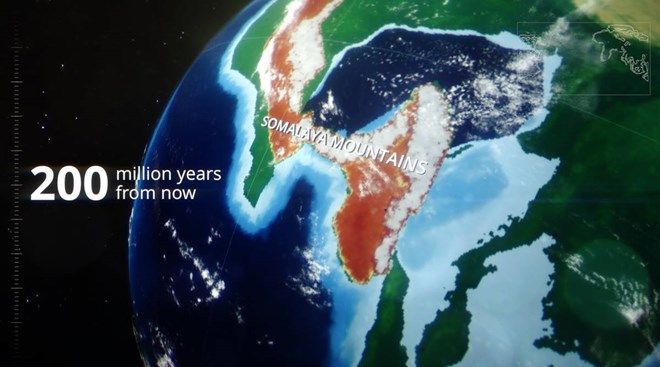India, Somalia and Madagascar may become one continent in 200 million years: Study

Source: The Indian Express, Saturday January 8, 2022

A study published recently in the American Journal of Science shows that east Africa (including modern Somalia, Kenya, Tanzania, and Mozambique), and Madagascar, will override India in about 200 million years.
This will also lead to the ‘formation of a long mountain range along the modern west coast of India’ which the team named ‘Somalaya’.
Speaking to indianexpress.com, Utrecht University geologist Prof. Douwe van Hinsbergen, who led the team, said ‘we now have the answer as to how the mountains and continents of the future will look like.
“I had made reconstructions of the past – of a continent that disappeared in the Mediterranean region, another major continent that disappeared in Southeast Asia whose relics we find all over Indonesia. But I had never made any future simulations. But the question caught my attention and I discussed it with my student and after about two years we now have an answer,” said Dr. van Hinsbergen.
The research team noted that Seychelles and Mauritius islands will all be pushed up and Mumbai will lie at the foot of the Somalaya range, as New Delhi lies at the foot of the Himalayas today.
“You will get a depression in southwest India, from Trivandrum all the way to Karachi. And the Horn of Africa which includes Somalia will override or bulldoze over southwest India and make this big mountain belt,” explained Dr. van Hinsbergen.
How did they arrive at this conclusion?
Thomas Schouten, a PhD student at ETH Zürich, in Switzerland, and one of the authors explained: “We have so many studies that have reconstructed the past, for which we have knowledge on how tectonic plates moved – how fast, which way they went etc. In our study, we assumed that the rift that goes through the African continent and underlies the east African lakes will continue to split the two parts of Africa and an ocean will be formed in the next 200 million years.”
He added that when this space is created in Africa, we must remove space in the Indian Ocean. “So basically the beaches of Malabar will be scooped up like a bulldozer, and coral reefs, beaches, and low lying areas will fold up to become high peaks. Seychelles will also get placed next to the Lakshadweep and along with the Malabar sediments they may become a mountain range of eight kilometers high, similar to the Himalayas where we find old coral reefs at the tops of mountains like Everest,” explains Schouten.
Why break Africa?
The team explained that the fault lines along which two ancient continents collided in the past remain weak. “So, modern continents like Africa can break along those old fault lines. And it’s a similar thing to how India broke off from Madagascar, 90 million years ago,” explains Dr. van Hinsbergen “The most important thing to remember is, continents do not exist forever. India has existed as we know it today only for the last few tens of million years. Before that, it was an island. The Indian Ocean will surely close one day. And then there will be a continent hitting India. And it’s either Africa or Antarctica, or it might be Australia.”
In the construction of the future, the team looked at Africa. They added that they ignored Southeast Asia, which will likely collide with east India. “India may sometime in the future even look like Mongolia – situated right in the middle of an enormous supercontinent surrounded by high mountain ranges of which the Somalaya may be one,” said Dr. van Hinsbergen.
The team said that the main goal was to think through which features of the modern Indian Ocean will be preserved in mountain belts, and which may not. This helps to better reconstruct the history of the Earth’s plates and surfaces of the geological past, which is important to help understand the evolution of climate, life, and resources.
In the construction of the future, the team looked at Africa. They added that they ignored Southeast Asia, which will likely collide with east India. “India may sometime in the future even look like Mongolia – situated right in the middle of an enormous supercontinent surrounded by high mountain ranges of which the Somalaya may be one,” said Dr. van Hinsbergen.
The team said that the main goal was to think through which features of the modern Indian Ocean will be preserved in mountain belts, and which may not.
This helps to better reconstruct the history of the Earth’s plates and surfaces of the geological past, which is important to help understand the evolution of climate, life, and resources.

